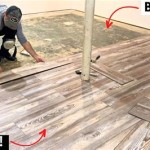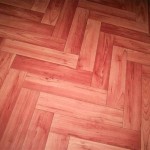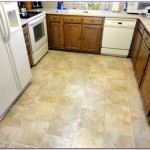Is Vinyl Plank Flooring Safe for Your Home? A Comprehensive Assessment
Vinyl plank flooring has surged in popularity as a versatile and affordable alternative to traditional hardwood and tile. Its durability, water resistance, and ease of installation make it an attractive option for homeowners and businesses alike. However, questions surrounding the safety of vinyl plank flooring persist, often centering on the materials used in its manufacture and their potential impact on indoor air quality and human health. This article seeks to explore these concerns, providing a balanced and comprehensive assessment of the safety aspects associated with vinyl plank flooring.
Understanding the composition of vinyl plank flooring is crucial to evaluating its safety. Vinyl plank flooring typically consists of several layers, each contributing to its overall performance. The core layer is often made of PVC (polyvinyl chloride), a synthetic plastic polymer. Other layers may include a wear layer for durability, a decorative print layer for aesthetics, and a backing layer for stability and sound absorption. Some vinyl plank flooring products also incorporate a foam or cork underlayment for added comfort and insulation.
The manufacturing process of vinyl plank flooring can vary, leading to differences in the types and amounts of additives used. These additives, such as plasticizers, stabilizers, and pigments, are essential for achieving the desired properties of the flooring, including flexibility, durability, and color. However, some of these additives have raised concerns regarding their potential health effects.
Key Point 1: Examining Volatile Organic Compounds (VOCs)
One of the primary concerns related to the safety of vinyl plank flooring is the potential emission of volatile organic compounds (VOCs). VOCs are organic chemicals that evaporate at room temperature and can contribute to indoor air pollution. Common VOCs found in building materials include formaldehyde, benzene, and toluene. Exposure to VOCs can cause a range of health effects, including eye, nose, and throat irritation, headaches, dizziness, and in some cases, more serious respiratory problems.
The emission of VOCs from vinyl plank flooring is influenced by several factors, including the type and amount of additives used in the manufacturing process, the age of the flooring, and the ventilation of the room. Newer vinyl plank flooring tends to emit VOCs at a higher rate than older flooring, as the chemicals gradually off-gas over time. Poorly ventilated rooms can trap VOCs, leading to higher concentrations and increased exposure.
To mitigate the risk of VOC emissions, it is important to choose vinyl plank flooring products that are certified by independent organizations such as FloorScore, Greenguard, or UL GREENGUARD. These certifications indicate that the flooring has been tested and meets stringent standards for low VOC emissions. Look for products labeled as "low-VOC" or "VOC-free" to further minimize potential exposure. Furthermore, ensuring adequate ventilation in the room during and after installation can help to dissipate any VOCs that may be released.
It's also essential to allow the flooring to off-gas prior to installation, if possible. Unpack the planks and allow them to air out in a well-ventilated area for several days before installing them. This can help to reduce the initial concentration of VOCs released into the indoor environment.
Key Point 2: Phthalates and Their Potential Health Impacts
Phthalates are a group of chemicals that are commonly used as plasticizers in vinyl products, including vinyl plank flooring. They are added to PVC to make it more flexible and pliable. However, some phthalates have been linked to potential health concerns, including endocrine disruption, developmental problems, and reproductive issues.
The concern with phthalates stems from the fact that they are not chemically bound to the PVC and can leach out of the material over time. Exposure to phthalates can occur through inhalation, ingestion, or skin contact. Children are particularly vulnerable to the effects of phthalates, as they may crawl on the floor and put their hands in their mouths.
To address concerns about phthalates, many manufacturers have begun to phase out the use of certain types of phthalates that have been identified as potentially harmful. Look for vinyl plank flooring products that are labeled as "phthalate-free" or "ortho-phthalate-free." These products typically use alternative plasticizers that are considered to be safer.
Regulatory bodies such as the Consumer Product Safety Commission (CPSC) have also implemented stricter regulations regarding the use of phthalates in children's products. While these regulations may not directly apply to vinyl plank flooring, they reflect a broader effort to reduce exposure to potentially harmful phthalates.
When researching vinyl plank flooring options, inquire about the phthalate content of the product. Manufacturers should be able to provide information about the types of plasticizers used in their flooring and whether they comply with relevant safety standards.
Key Point 3: Understanding Heavy Metals and Additives
In addition to VOCs and phthalates, some vinyl plank flooring products may contain heavy metals or other additives that have raised safety concerns. Heavy metals such as lead, cadmium, and mercury can be used as pigments or stabilizers in vinyl products. Exposure to heavy metals can have a variety of adverse health effects, including neurological damage, kidney problems, and developmental issues.
The use of lead in vinyl products has been largely phased out in many countries due to its well-documented health risks. However, some older vinyl plank flooring products may still contain lead. Cadmium and other heavy metals may still be used in some applications, although their use is generally regulated.
To minimize the risk of exposure to heavy metals, it is important to choose vinyl plank flooring products that are certified as lead-free and meet relevant safety standards for heavy metal content. Look for products that have been tested and certified by independent organizations such as the NSF International. These certifications ensure that the flooring has been evaluated for its chemical composition and meets established safety criteria.
Furthermore, be aware of the presence of other additives in vinyl plank flooring, such as flame retardants and antimicrobials. While these additives may provide certain benefits, they can also pose potential health risks. Flame retardants, for example, have been linked to endocrine disruption and developmental problems. Antimicrobials can contribute to the development of antibiotic-resistant bacteria.
Whenever possible, opt for vinyl plank flooring products that use safer alternatives to potentially harmful additives. Choose products that are free of flame retardants, antimicrobials, and other chemicals of concern. Read the product labels carefully and ask manufacturers for information about the composition of their flooring.
Beyond the specific chemicals mentioned above, it's important to consider the overall impact of vinyl plank flooring on indoor air quality. Regular cleaning and maintenance can help to reduce the accumulation of dust and allergens, which can contribute to respiratory problems. Use a damp mop or vacuum cleaner with a HEPA filter to remove dust and debris from the flooring. Avoid using harsh chemicals or abrasive cleaners, as these can damage the flooring and release harmful VOCs.
The installation process itself can also affect indoor air quality. Adhesives used to install vinyl plank flooring can emit VOCs. Choose low-VOC adhesives or opt for click-lock vinyl plank flooring that does not require adhesives. Ensure adequate ventilation during and after installation to allow any VOCs to dissipate.
Choosing a reputable manufacturer is also crucial. Established companies are more likely to adhere to strict quality control standards and use safer materials in their products. Look for manufacturers that are transparent about the composition of their flooring and provide detailed information about their safety certifications.
Finally, remember that no flooring material is completely risk-free. Even natural materials like hardwood and tile can release allergens or contribute to indoor air pollution under certain conditions. The key is to make informed choices based on your individual needs and priorities. Consider the potential benefits and risks of each flooring option and choose the one that best meets your requirements for safety, durability, and aesthetics.

The Dangers Of Luxury Vinyl Floors Lvt And How You Can Avoid Them Artisan Wood Llc

The Disadvantages Of Vinyl Plank Flooring A Guide Reallyfloors America S Est Hardwood

The Dangers Of Luxury Vinyl Floors Lvt And How You Can Avoid Them Artisan Wood Llc

6 Vinyl Flooring Myths Get The Facts From Our Experts

What I Ve Learned As An Inspector For Luxury Vinyl Flooring Wood Floor Business

Non Toxic Vinyl Plank Flooring Brands The Risks My Chemical Free House

A Beginner S Guide To Installing Vinyl Plank Flooring Dumpsters Com

The Toxic Problem With Vinyl Flooring That No Warned You About

How To Choose The Right Vinyl Plank Deerfoot Carpet Flooring

What I Ve Learned As An Inspector For Luxury Vinyl Flooring Wood Floor Business
Related Posts








